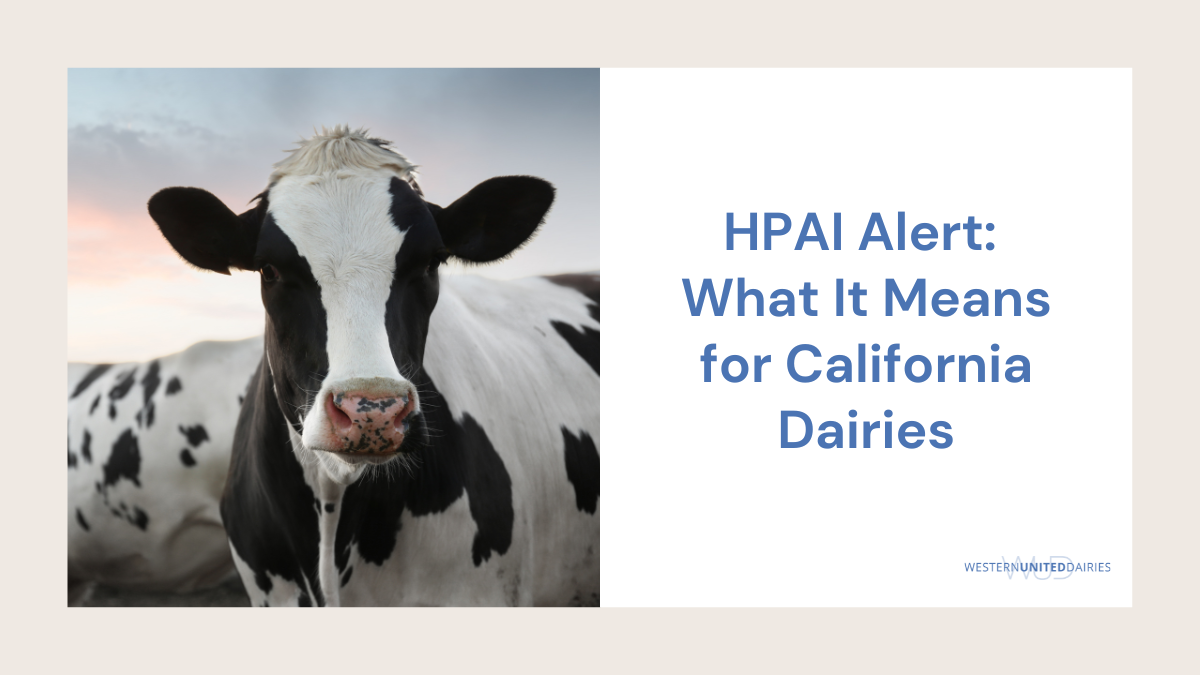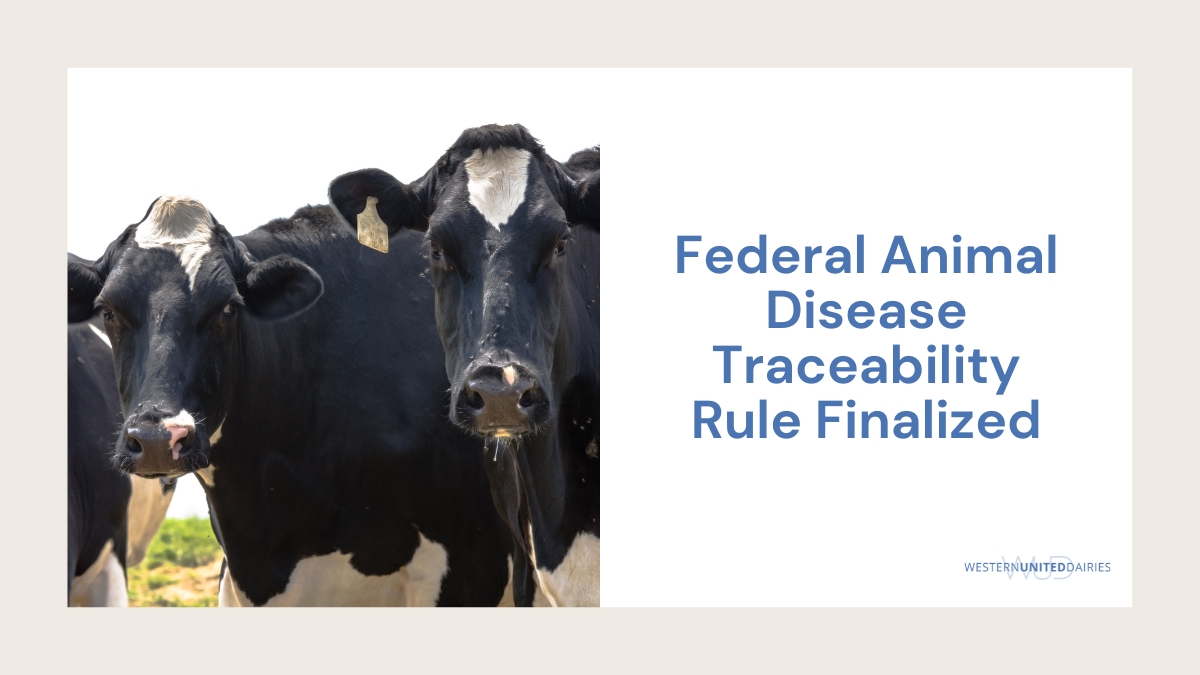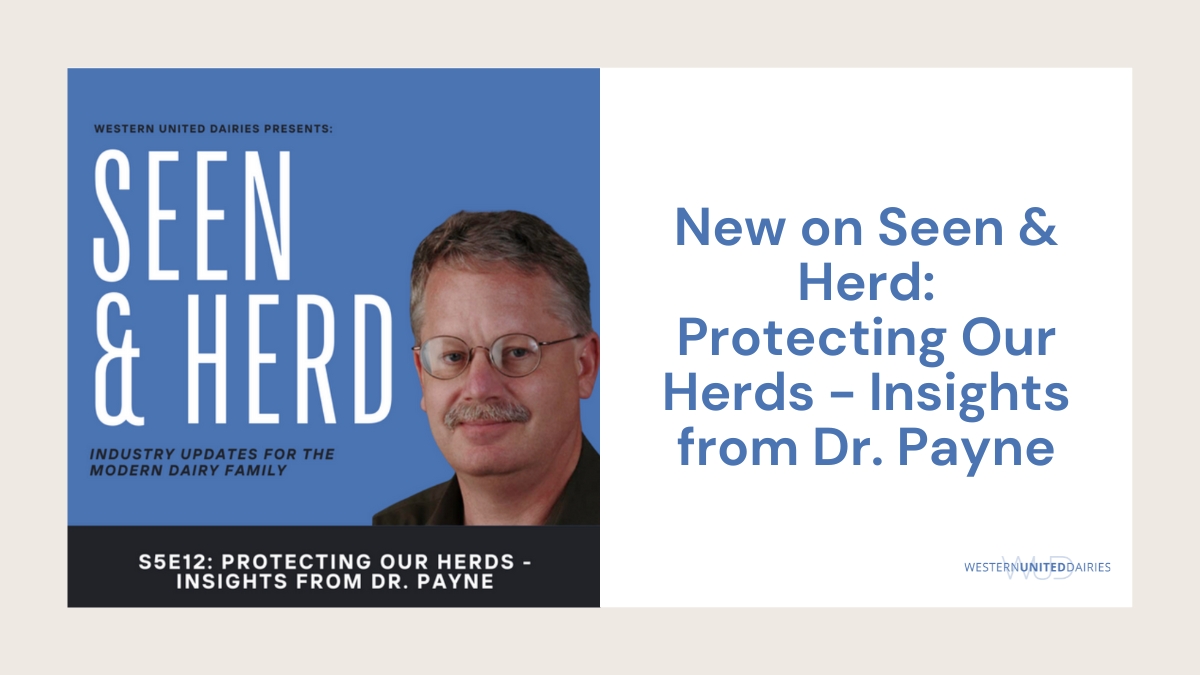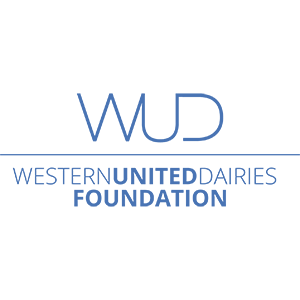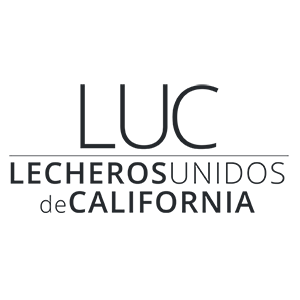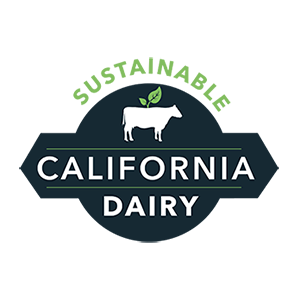Protecting Your Herd
By far the most important precautions producers can take are ones that can be implemented unilaterally and immediately:
If it’s not possible to close your herd, the best protection is rigid adherence to a 30-day isolation period for new or returning cattle. Isolation paired with pre-movement testing offers the greatest protection. CDFA offers free voluntary testing demonstrating either your herd, or a source herd, is disease free. For more information, contact your local CDFA district office. For heifers raised off-site, ensure that springers are either tested before movement and/or returned to the dairy and quarantined 30 days prior to calving.
In order to be effective, the isolation area will not allow nose-to-nose contact with resident cows and will not share a water source. Such isolation requirements may be difficult to meet on the home dairy and use of an alternative isolation location may be necessary. Isolation should also apply to returning show or fair animals.
Almost two thirds of new Michigan dairy infections did not involve transfer of live animals. This suggests that cleaning and disinfection before and after use of shared vehicles with an approved disinfectant is critical. If at all possible, use only your own trailers to transport only your own animals.
Unpublished data suggest that physical virus transfer by people is critically important in disease spread. This makes sharing employees a high-risk practice. A powerful biosecurity practice is for farm employees to use farm-specific boots and coveralls that never leave the dairy. This practice becomes even more important if you can’t prevent employees from having outside animal contact.
All delivery vehicles (feed, milk tankers, rendering) should use designated paths and parking areas that do not cross farm vehicle paths. Milk tankers require special consideration. See below.
Infected milk is the primary method of disease spread. Producers should understand what PPE and hygiene practices processors expect from their haulers. Processors may choose to dedicate certain trucks for use only on infected farms. Producers can also have employees clean and disinfect the milk house after milk pick-ups, with special attention to milk spilled during transfer. See page 34 of USDA’s Secure Milk Supply (SMS) program’s standards for Raw Milk Collection & Transport. The SMS biosecurity standards were developed for use during a Foot and Mouth Disease outbreak, but will also be effective in limiting HPAI spread between dairy farms.
CDFA and CDQAP delivered a webinar on best practices for dairy visitors. See this article which includes a checklist and a link to the webinar’s recording. In addition, work with essential visitors (veterinarians, AI and equipment technicians, hoof trimmers) to develop biosecurity plans tailored to their function.
Early segregation of infected animals into a hospital string can greatly limit within-herd spread and financial losses. Train and empower employees to both follow your farm’s biosecurity protocols as well as report suspicious symptoms in cattle. English and Spanish training aids for employees are available.
The California Department of Public Health (CDPH) has PPE recommendations for farm workers who handle raw milk in English and Spanish. Disposable gloves and N95 masks, along with non-disposable personal goggles or face shield, provides robust protection. At a minimum, producers should empower employees to report illness, particularly with respiratory, cold/flu or eye symptoms, so they may seek medical attention and treatment. Producers should also strongly discourage employee consumption of raw, unpasteurized milk from the farm.
Request PPE
To request PPE, please fill out the form, and we will place the order for you. If you have any questions, please reach out to us at info@wudairies.com.
Additional Resources
Farms in California affected by High Pathogen Avian Influenza (HPAI) may be eligible for relief payments available through USDA’s Farm Service Agency via the Emergency Assistance for Livestock, Honeybees, and Farm-Raised Fish Program (ELAP).
According to estimates provided by Ever.Ag, USDA’s formulas could provide California dairy producers with as much as $375 per eligible cow for August and $386 per eligible cow for September. Estimates for October are forthcoming.
The formula calculates milk loss based on a 21-day period of no milk production when a cow is removed from the milking herd, followed by seven days when the cow has returned to milking but produces 50% of the normal amount of production. USDA uses the monthly All Milk Price, national milk production figures, and a 90% adjustor to determine the per cow rate.
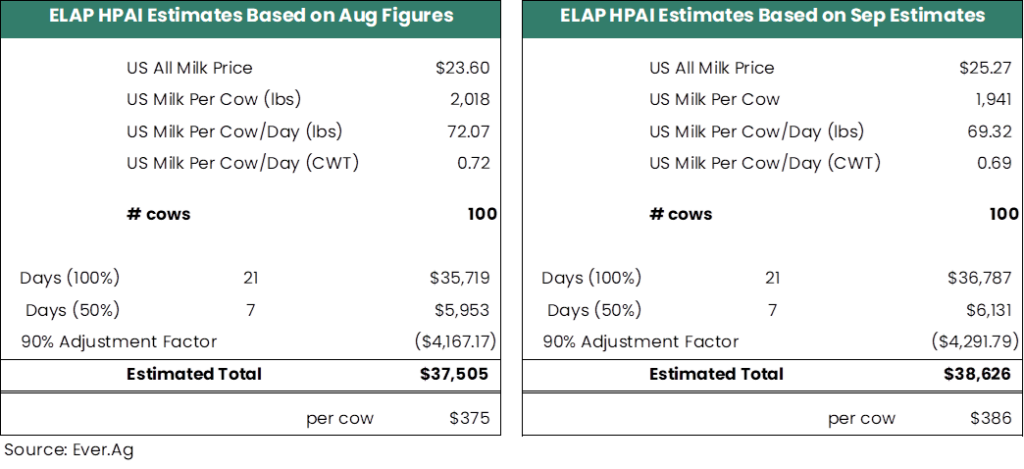
Here’s how producers qualify and apply for coverage:
- Eligible producers must have had reduced milk production as a result of removal of adult dairy cows from the milking herd due to H5N1 infection.
- Producers apply to receive ELAP assistance at local FSA service centers. Producers have until January 30, 2025, to file applications for the 2024 program year.
- Applications must include:
- Proof of herd infection through a confirmed positive H5N1 test on individual animals or bulk tank samples confirmed by APHIS
- A notice of loss indicating the date when the loss is apparent (which is the sample collection date for the positive H5N1 test).
- An application for payment certifying the number of eligible adult dairy cows removed from production, the month the cows were removed from production, and the producer’s share in the milk production.
- Producers must be prepared to provide current and prior year milk production records and herd inventory records if requested by FSA.
- Eligible adult dairy cattle must be:
- Part of a herd that has a confirmed positive H5N1 test from APHIS at NVSL
- Initially removed from commercial milk production during the 14-day time period prior to the sample collection date for the positive H5N1 test date through 120 days after the sample collection date for the positive H5N1 test. If a producer continues to remove cows from the herd after 120 days from the prior provided positive test, a subsequent positive test after the 120 days in required and another notice of loss and application for payment is required.
- Milk-producing, currently lactating and maintained for commercial milk on the beginning date of the eligible loss condition.
USDA materials note that the 2018 Farm Bill removed ELAP from the combined $125,000 payment limitation. The average adjusted gross income (AGI) limitation relating to limits on payments for persons or legal entities, excluding joint ventures and general partnerships, with certain levels of AGI will apply. Specifically, a person or legal entity with an AGI that exceeds $900,000 will not be eligible to receive ELAP payments. We urge producers to work with their FSA office to determine eligibility.
Head over to your local FSA office to start the application process. There is a good chance a number of these items are already on file for your dairy.
- Biosecure Point Sign – English & Spanish
- Biosecurity Entry Sign – English | Spanish
- International Travel Biosecurity Tips
- CDFA Biosecurity Homepage – The jumping off point for information biosecurity information for all species.
- CDFA California Dairy Farm Premises Enhanced Biosecurity Plan Template
- Biosecurity Self-Assessment Checklist
- CDQAP Biosecurity Measures for Dairy Visitors
- FREE Online Biosecurity Training
- NMPF / Dairy FARM Program Biosecurity Homepage – The homepage for the National Milk Producer Federation’s biosecurity outreach program.
- NMPF / Dairy FARM Program Everyday Dairy Biosecurity Manual – This colorful, comprehensive manual describes with words, diagrams and pictures practices which will help keep your farm free of routine disease incursions.
- Biosecurity Guidance for Dairy Regulatory Inspections Visiting a Dairy Farm (ca.gov)
- Biosecurity Guidance for Livestock Haulers Visiting a Dairy Farm (ca.gov)
- Biosecurity Guidance for Feed Haulers Visiting a Dairy Farm (ca.gov)
- Biosecurity Guidance for Milk Haulers Visiting a Dairy Farm (ca.gov)
New Fact Sheets from AABP, NMPF and FARM – The American Association of Bovine Practitioners, the National Milk Producers Federation and the national FARM program released on August 28th 2024 three new collaborative fact sheets that benefit from the most recent laboratory research and epidemiologic studies.
- Dairy Cattle: Biosecurity for H5N1 Virus – Focused on the most important biosecurity actions producers can take.
- Spread and Prevention of H5N1 Virus in Dairy Cattle – Understanding how it spreads makes it easier to prevent.
- Secure Milk Supply Plan: Enhanced Biosecurity for H5N1 – Explains the State/Federal collaborative Secure Milk Supply (SMS) program’s enhanced biosecurity measures.
News
Train the Trainer Seminar
outlawmd2024-11-07T13:04:51-08:00November 5, 2024|
Video Podcast Presentations CDPH ...
HPAI Alert: What It Means for California Dairies
outlawmd2024-09-09T09:28:09-07:00August 30, 2024|
In this week's episode of Seen and Herd, we ...
Federal Animal Disease Traceability Rule Finalized
outlawmd2024-05-28T15:23:05-07:00May 21, 2024|
As many are aware, APHIS has released the final wording ...
New on Seen & Herd: A Bird’s Eye View on the Avian Influenza with Anja Raudabaugh
outlawmd2024-05-28T15:23:01-07:00April 22, 2024|
In this episode of Seen and Heard, we welcome back ...
Keeping Herds Safe from Bird Flu
outlawmd2024-05-28T15:22:57-07:00April 22, 2024|
By Dr. Michael Payne, UC Davis, School of Veterinary Medicine ...
New on Seen & Herd: Protecting Our Herds – Insights from Dr. Payne
outlawmd2024-05-28T15:23:19-07:00April 16, 2024|
In this episode of Seen and Heard, Amanda Russell, the ...

